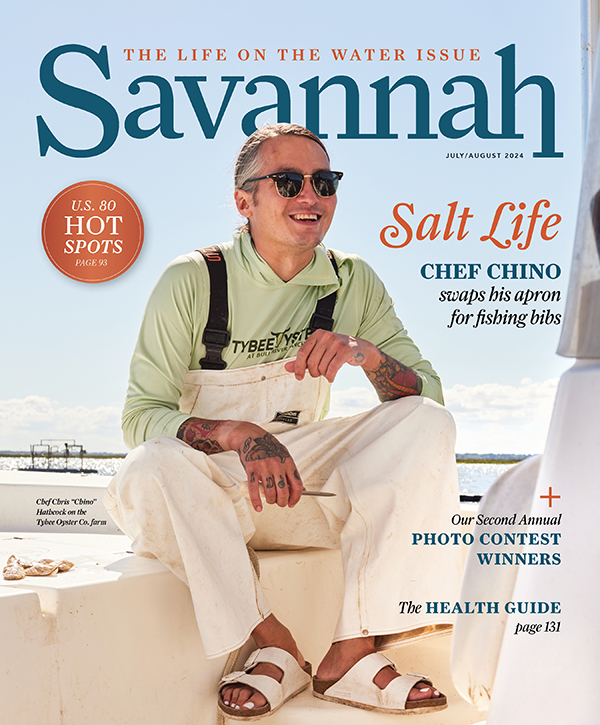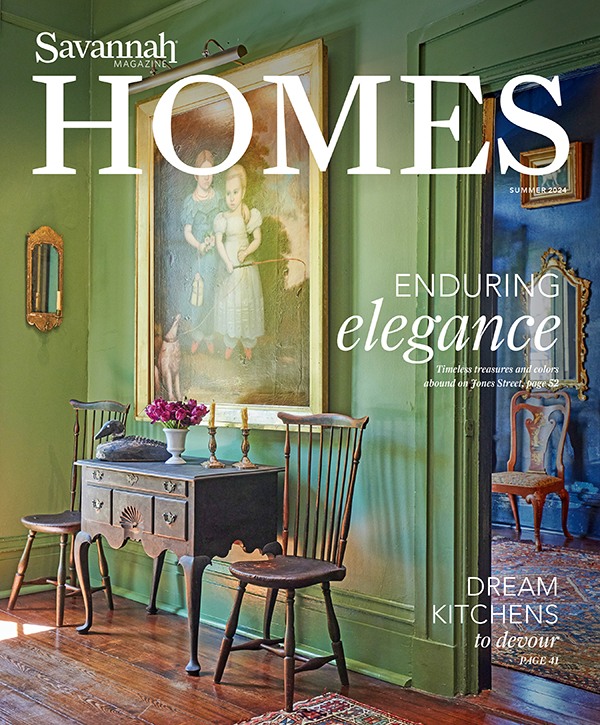Four decades of living design
Those of us who’ve been there know that at 40 years old, you’re just hitting your stride. You’ve suffered the slings and arrows of youthful mistakes and gained enough perspective to sidestep the nonsense. If you’re prudent, creative and lucky, you’re able to find your groove, a sense of purpose and a level of confidence for a future full of possibility.
As it enters its fifth decade, the Savannah College of Art and Design resembles such a living, breathing body, one nourished by its founding vision. While SCAD’s innovative spirit soars far beyond its colorful containers, the “head, hand and heart” of Professor Emeritus Hugh Gale’s SCAD@40 logo represents the true synergy of a university that continues to enrich and expand its historic footprint with vibrant, new spaces.
From the high-tech laboratories of The Shed, a collaboration between the School of Design and the School of Digital Media, where glorious paintings are created in virtual reality, to the enchanted nooks of new admissions hub Ruskin Hall, SCAD’s recent design projects amount to far more than a “facelift” or a collection of pretty rooms. Instead, they’re SCAD’s mission made material, places that prepare students to bring their talent and ingenuity to the workplace and world.
Over the past 40 years, SCAD has earned its place in Savannah history by preserving vital architecture and inspiring students to create beautiful narratives and elegant solutions. Looking ahead to the next 40 years, it feels impossible to guess where the algorithms will take us and what new forms of media will burst forth. But if history is any indication, we can be sure SCAD will be there, leading the charge.

A Q&A with SCAD Founder Paula Wallace
In 1979, a young teacher arrived in Savannah in a Volkswagen Beetle with a vision of opening an art college. Forty years later, the Savannah College of Art and Design has realized so many other dreams — millions of canvases created, hundreds of thousands of careers ignited and dozens of neighborhoods revitalized.
As SCAD continues to cultivate new generations of artists and designers as well as transform the Savannah skyline and beyond, President Paula S. Wallace considers how the city has been a partner all along.
Where do you see the line between the city and the university?
I don’t really see a line, because we live here, our friends and families are here. Even when you think of a SCAD student, who may spend four or six years here, that’s a pretty long time. I think they feel like Savannah is home as well.
I notice that a lot of alumni want to come back to get married or for vacations — I’ll be on Delta flying home and meet an alum from ’86 or ’92 and they’ll say, “I just wanted to come to Savannah for the weekend.” One important function of SCAD has been to create so many ambassadors for Savannah.

Why has it been important to expand SCAD’s footprint beyond downtown?
As the student body has grown, we’ve needed to add more resources and connect them. Where the Hive [new student dorm] is now [near West Boundary Street], there were once two hotels. Now that whole Turner corridor goes into the SCAD Museum of Art, which, when I first saw it, was just a pile of rubble and barbed wire.
One reason we’ve expanded to some of these further neighborhoods is that we need larger buildings — we need classrooms that students can work in, spread out in, experiment in, and they’re not necessarily in the city center. Each new building impacts a whole neighborhood — with foot traffic, landscaping and enhanced lighting.
Would SCAD have worked somewhere else?
I can’t really say. I thought the frisson of the old and new here produced something that was very special. Since then, Atlanta has also become a wonderful hometown for SCAD; Hong Kong and Lacoste, as well. Once a student is enrolled in SCAD, he or she can study at any campus — gaining different professional networks, learning a whole different culture. That whole educational philosophy begins here in Savannah.
After 40 years, what you’ve called a “scholastic experiment” has matured into something like an academic institution, but that can’t be the right word for something far more vibrant and responsive. How do you keep the vision flexible and dynamic?
Well, I listen to the students. That’s why we have a fashion major — and of course, now we’re very well-known for fashion. I also listen to the professionals, which is why we’ve recently added some new majors. For instance, Carol Hamilton of L’Oreal suggested to me that we have a business of beauty and fragrance major.
Refinery 29 helped us develop our social media strategy and management degree, and it was Disney that first suggested that we have a themed entertainment degree. And Google partnered with us to develop our UX program.
So we see these needs in the marketplace where our graduates are going to be soon employed and leading the way, and when we see a demand for a new profession and we realize other colleges aren’t really embracing some of these new professions, we create them.
We still have the same DNA as we did at the beginning of SCAD — the attention to the individual, honing a strong work ethic, small classes, emphasis on educational research — all these things have still been maintained as part of our character, that hasn’t changed. But adapting to the professions of the future — that’s always changing.

The new Ruskin Hall is so magical, it feels like Hogwarts. What are your favorite new design details?
It actually was inspired by Hogwarts, indirectly at least! A student from Panama told me years ago when she walked into Poetter Hall that it reminded her of Harry Potter and said, “We can fly here! We can create magic here!” So we were striving to create the collegiate version of Hogwarts with Ruskin.
I love all of these buildings. But if you took out the art, our buildings would not be what they are. We respect the architectural bones and character, but we always enliven with art. It really all begins with the art. We don’t take design so seriously as we would for a hotel or another commercial purpose — this is all for our students. We care about it appealing to them.
Of course, people come into our environments and start wanting to buy the paintings off the walls. So we created SCAD Art Sales, because of course we want our alumni’s work to get out into as many difference collections as possible.
What role do collections and assemblages in particular spaces play in the learning environment?
When you walk around our buildings, you’ll notice art from our alumni and faculty everywhere, as well as all kinds of curiosities: We’ll happen upon something that is visually interesting, that tells a story, and we’ll incorporate it — we have a huge abacus at the campus in Lacoste that came from Hong Kong. Or we’ll be in the French countryside at the antiques market in L’isle-sur-la-Sorgue and find things there that we might put in the campus in Atlanta.
These spaces reference and speak to the strengths of our students and their art, expressing our respect for them and emphasizing how much we care about their experience. We try to create environments that are full of surprise and delight. When you walk around a corner at a building at SCAD, you never know what you’re going to find.
That is always true! Yet innovation requires risks. Are the any design regrets, perhaps a misconceived plaid wall in the ’90s or enthusiasm for certain trends that didn’t pan out?
Well, we did strip the wood in the Poetter Hall foyer and paint it lime green. There was an outcry! Now we’ve stripped it back. You have to respect people’s response. But you know, we’ll try things, and maybe we go back to the way it was.
I do remember that I picked out a Karastan carpet with purple and red stripes for an art gallery, and people were aghast! They said, “Why would you put something like that in a gallery?” I thought that people would want to see art in a home-like setting, someplace that wasn’t just white white white. Would I do that again? Probably not.
How do you describe Savannah when you travel the world?
It’s a city of innovation. I think the common belief about Savannah is that it’s historical, classical, charming — and it is all of those things.
When you think about it, from the very beginning — from Oglethorpe’s city plan to the Grand Prix racing that Savannah was known for — there have always been risk takers here. There have always been people pushing the envelope, trying new things in our quaint, charming Southern town.
We’ve always been a city defined by diversity, and thank goodness for all the variety we have. It’s not just one note in Savannah. It’s like a whole orchestra.


